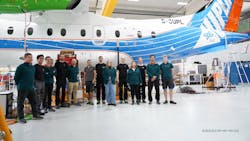Deutsche Aircraft and DLR Complete Ground Vibration Test on D328 UpLift Demonstrator
Deutsche Aircraft, in collaboration with the German Aerospace Center (DLR) Institute of Aeroelasticity, has successfully completed a Ground Vibration Test (GVT) on the D328 UpLift flying testbed, D-CUPL.
This marks a step forward in the UpLift program, an initiative funded by the Federal Ministry for Economic Affairs and Energy to accelerate the maturation of new technologies for sustainable aviation.
What is the GVT?
The Ground Vibration Test helps to determine an aircraft’s modal properties, such as its natural frequencies, damping ratios and mode shapes. This information is essential for validating structural dynamics and refining the numerical models used in flutter analysis and loads calculation.
A Test of Precision and Scale
Over a two-week test period, the D328 UpLift was suspended using actively controlled air springs. The structure was excited at over 20 locations using electrodynamic shakers, while 237 acceleration sensors captured the dynamic response.
Key test outcomes:
- 3 aircraft configurations
- 45 hours of excitation time
- 50 distinct eigenforms identified
Senior Engineer, Loads & Aeroelastics, at Deutsche Aircraft Simon Binder stated, “This successful GVT campaign is a cornerstone in validating the Global Finite Element Model (GFEM) in support of the structural modifications designed for the UpLift D-CUPL.”
“With the ground vibration test, we have reached an important milestone in the UpLift project,” added Julian Sinske from the DLR Institute of Aeroelasticity.
Sinske continued, “We can now evaluate upcoming modifications to the research aircraft in terms of their aeroelastic behavior. I’m pleased that we conducted the test efficiently and achieved high-quality results. The new air spring support played a decisive role in this.”
The D328 UpLift aims to enable real-world testing of future propulsion and energy systems, sustainable fuels and advanced systems integration to encourage innovation in aviation.
